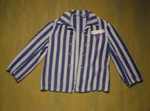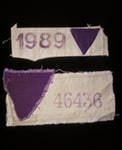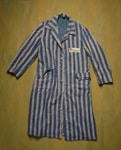
SS guards used badge markings on concentration camp uniforms to identify a prisoner’s category. n 1937 Jehovah’s Witnesses (Bibelforscher) were designated by their own symbol – a purple triangle. Concentration camp uniforms were made from cotton fabric and used even in winter, with the purple triangle easily visible on the jacket.
The horizontal categories list markings for the following types of prisoners: political, professional criminal, emigrant, Jehovah’s Witnesses, homosexual, Germans shy of work, and other nationalities shy of work. The vertical categories begin with the basic colors, and then show those for repeat offenders, prisoners in punishment kommandos, Jews, Jews who have violated racial laws by having sexual relations with Aryans, and Aryans who violated racial laws by having sexual relations with Jews. The remaining symbols give examples of marking patterns.
Date: Circa 1938 – 1942
Locale: Dachau,[Bavaria] Germany
Credit: USHMM, courtesy of Dachau Concentration Camp Memorial
Copyright: Public Domain
Categories of Concentration Camp Prisoners (Excerpt)
By Henry Friedlander
Professor of History in the Department of Judaic Studies at Brooklyn College of the City University of New York. Deported 1941 from Berlin to Lodz ghetto and 1944 to Auschwitz-Birkenau, Neuegamme, Ravensbrück men’s camp, emigrated to the United States in 1947.
“( . . . ) A few Jehovah’s Witnesses could be found in the concentration camps right from the beginning, but most were committed between 1935 and 1939. During these years the number of Witnesses increased to at least 10 percent of the number of camp inmates. And in some camps their number increased to an even higher percentage. They were not counted among the political prisoners and naturally could not be counted among the criminals. They were an independent group and wore the purple triangle. They were persecuted, arrested, and committed to the camps, all because of their religious conviction. In this respect they occupied an exceptional position in the concentration camps. The purple triangle thus stood only for Jehovah’s Witnesses and not for all prisoners of the religious opposition. Unlike Catholic priests, who wore the red triangle of the political prisoners, the Witnesses were not classified as “political” enemies. ( . . . )”
Excerpt from “Persecution and Resistance of Jehovah’s Witnesses under National Socialism” by Hans Hesse ; Bremen: Edition Temmen 2001, p. 17, 18. (ISBN 3-86108-750-2)
United States Holocaust Memorial Museum
Jehovah’s Witnesses (Excerpt)
Teresa Wontor-Cichy
Researcher at the State Museum Auschwitz-Birkenau
“(…) Under the prisoner classification system, Jehovah’s Witnesses wore a purple triangle and an “IBV” symbol, an abbreviation for the official name of their organization in German, Internationale Bibelforscher – Vereinigung (International Association of Bible Researchers). Partially extant camp records in the Archives of the Auschwitz-Birkenau State Museum, together with memoirs by former prisoners, indicate that other prisoners arrested because of their religious convictions, including clergy of various denominations, also wore the purple triangle in the camp. However, Jehovah’s Witnesses made up the decided majority of prisoners in this category. (…)”Memorial and Museum AUSCHWITZ-BIRKENAU





